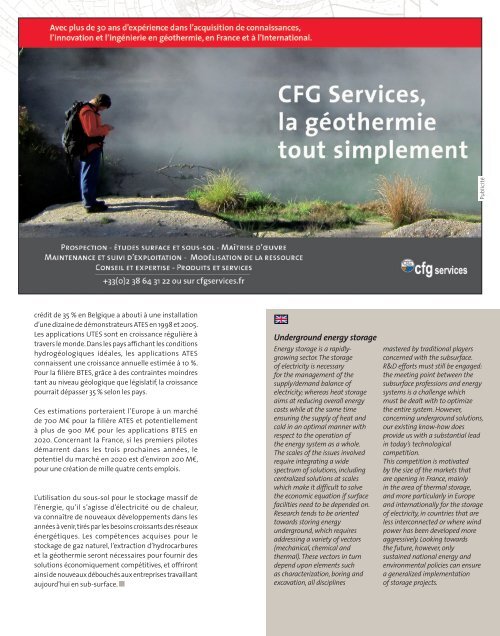revue_geosciences16
revue_geosciences16
revue_geosciences16
Create successful ePaper yourself
Turn your PDF publications into a flip-book with our unique Google optimized e-Paper software.
crédit de 35 % en Belgique a abouti à une installation<br />
d’une dizaine de démonstrateurs ATES en 1998 et 2005.<br />
Les applications UTES sont en croissance régulière à<br />
travers le monde. Dans les pays affichant les conditions<br />
hydrogéologiques idéales, les applications ATES<br />
connaissent une croissance annuelle estimée à 10 %.<br />
Pour la filière BTES, grâce à des contraintes moindres<br />
tant au niveau géologique que législatif, la croissance<br />
pourrait dépasser 35 % selon les pays.<br />
Ces estimations porteraient l’Europe à un marché<br />
de 700 M€ pour la filière ATES et potentiellement<br />
à plus de 900 M€ pour les applications BTES en<br />
2020. Concernant la France, si les premiers pilotes<br />
démarrent dans les trois prochaines années, le<br />
potentiel du marché en 2020 est d’environ 200 M€,<br />
pour une création de mille quatre cents emplois.<br />
L’utilisation du sous-sol pour le stockage massif de<br />
l’énergie, qu’il s’agisse d’électricité ou de chaleur,<br />
va connaître de nouveaux développements dans les<br />
années à venir, tirés par les besoins croissants des réseaux<br />
énergétiques. Les compétences acquises pour le<br />
stockage de gaz naturel, l’extraction d’hydrocarbures<br />
et la géothermie seront nécessaires pour fournir des<br />
solutions économiquement compétitives, et offriront<br />
ainsi de nouveaux débouchés aux entreprises travaillant<br />
aujourd’hui en sub-surface. n<br />
underground energy storage<br />
Underground energy storage<br />
Energy storage is a rapidlygrowing<br />
sector. The storage<br />
of electricity is necessary<br />
for the management of the<br />
supply/demand balance of<br />
electricity; whereas heat storage<br />
aims at reducing overall energy<br />
costs while at the same time<br />
ensuring the supply of heat and<br />
cold in an optimal manner with<br />
respect to the operation of<br />
the energy system as a whole.<br />
The scales of the issues involved<br />
require integrating a wide<br />
spectrum of solutions, including<br />
centralized solutions at scales<br />
which make it difficult to solve<br />
the economic equation if surface<br />
facilities need to be depended on.<br />
Research tends to be oriented<br />
towards storing energy<br />
underground, which requires<br />
addressing a variety of vectors<br />
(mechanical, chemical and<br />
thermal). These vectors in turn<br />
depend upon elements such<br />
as characterization, boring and<br />
excavation, all disciplines<br />
Publicité<br />
mastered by traditional players<br />
concerned with the subsurface.<br />
R&D efforts must still be engaged:<br />
the meeting point between the<br />
subsurface professions and energy<br />
systems is a challenge which<br />
must be dealt with to optimize<br />
the entire system. However,<br />
concerning underground solutions,<br />
our existing know-how does<br />
provide us with a substantial lead<br />
in today’s technological<br />
competition.<br />
This competition is motivated<br />
by the size of the markets that<br />
are opening in France, mainly<br />
in the area of thermal storage,<br />
and more particularly in Europe<br />
and internationally for the storage<br />
of electricity, in countries that are<br />
less interconnected or where wind<br />
power has been developed more<br />
aggressively. Looking towards<br />
the future, however, only<br />
sustained national energy and<br />
environmental policies can ensure<br />
a generalized implementation<br />
of storage projects.












